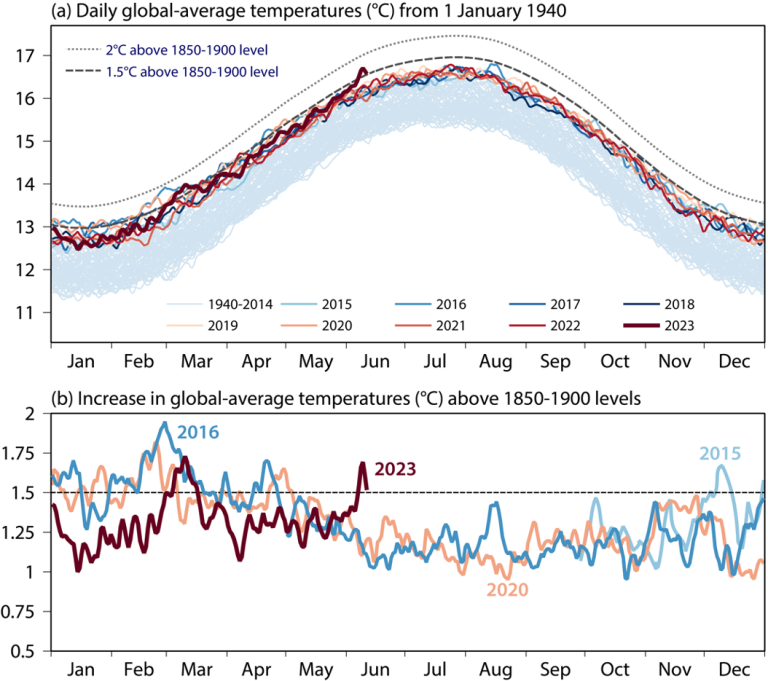Air and sea surface temperatures hit new records
A spate of new reports from the climate community have highlighted extraordinary temperatures both on land and at sea.

Global-mean surface air temperatures for the first days of June 2023 were the highest – by a considerable margin - for the time of year in the data record of the European Union’s Copernicus Climate Change Service (C3S) operated by ECMWF. This is after one of the warmest Mays on record.
Global sea surface temperatures hit a new high in May for the second consecutive month and in June are tracking at unprecedented levels for this time of year, in particular in the North Atlantic. Antarctic sea ice extent reached a record low monthly value in May, the third time in 2023 that the monthly value has reached a record low.
The extraordinary sea surface temperatures are ringing alarm bells, according to Dr Anthony Rea, Director of Infrastructure at the World Meteorological Organization and head of the Global Climate Observing System.
“Globally, sea surface temperatures are on average 0.2 degrees warmer than at the same time last year. This may not sound like much but considering the total surface of the global oceans and their calorific capacity, it represents in fact an enormous amount of heat energy absorbed by the ocean. This comes with a cost, including likely impacts on weather patterns, cyclone intensification and loss of biodiversity, such as coral reef bleaching, “ said Dr Rea.

El Niño
The ocean absorbs more than 90 percent of excess energy from human activities. The "Earth Energy Imbalance continues to grow" and as a result, ocean heat and sea surface temperatures are rising. Global ocean temperature hit a record high in May for the second consecutive month. Sea surface temperatures remain exceptionally high in June as of today (16 June).
El Niño conditions are now starting to emerg as above-average sea surface temperatures strengthen across the equatorial Pacific Ocean, prompting NOAA’s Climate Prediction Center and the Tokyo Climate Center to announce the arrival of El Niño conditions which are expected to gradually strengthen into Northern Hemisphere winter 2023–24.
WMO will issue its next El Niño Update in early July, based on models and expert opinion from around the world, and this should provide an indication on the likely strength and duration of El Niño, which has a warming impact on global average temperatures, and influences temperature and rainfall patterns around the world.
In addition to El Niño, studies have shown that the warming of North Atlantic Sea Surface Temperature has an influence on rainy seasons in west Africa as well as over parts of South America, including North East Brazil. It is therefore crucial to closely monitor North Atlantic Sea Surface Temperature, in addition to El-Nino and other drivers of climate variations.
Even ahead of El Niño, the heat is rising.

The globe had its joint second warmest May on record according to C3S, and the third warmest according to NOAA. The datasets have slightly different results but confirm the underlying warming trend. WMO combines these, and four additional datasets, for its global climate reports.
The Northern Hemisphere had its second-warmest May on record. In the Southern Hemisphere, surface temperature ranked fourth warmest on record for the month. It was the warmest May on record for North and South America.
Amid the unusually high May temperatures in North America, several hundred wildfires broke out across Canadian forests, burning over 6 million acres and causing widespread air quality deterioration across much of Canada and the U.S in late May and early June.
For the third time in 2023, Antarctic sea ice extent reached a record low monthly value for the time of year within the satellite data record. At 8.8 million km2 on average, it was 1.8 million km2 (17%) below the 1991-2020 average for May, according to C3S.
It was wetter than average over most of southern Europe and in the west of Iceland; heavy precipitation led to floods in Italy and the western Balkans.
CO2 levels
In an ominous sign that climate change will continue to accelerate, levels of heat-trapping greenhouse gases are at new records.
Carbon dioxide levels measured at NOAA’s Mauna Loa observatory in Hawaii peaked at 424 parts per million in May, continuing a steady climb further into territory not seen for millions of years, according to the US National Oceanic and Atmospheric Administration (NOAA). Mauna Loa is the benchmark monitoring station in WMO's Global Atmosphere Watch network.
Measurements of CO2 obtained by NOAA’s Global Monitoring Laboratory averaged 424.0 parts per million (ppm) in May, the month when CO2 peaks in the Northern Hemisphere. That's an increase of 3.0 ppm over May 2022.
Carbon dioxide levels are now more than 50% higher than they were before the onset of the industrial era. The findings are of particular concern, given that the lifetime of CO2 in the atmosphere lasts for many decades, thus committing the planet to future warming. WMO will combine measurements from stations around the world to issue its 2023 Greenhouse Gas Bulletin ahead of the UN Climate Change Conference, COP28, in the United Arab Emirates.










